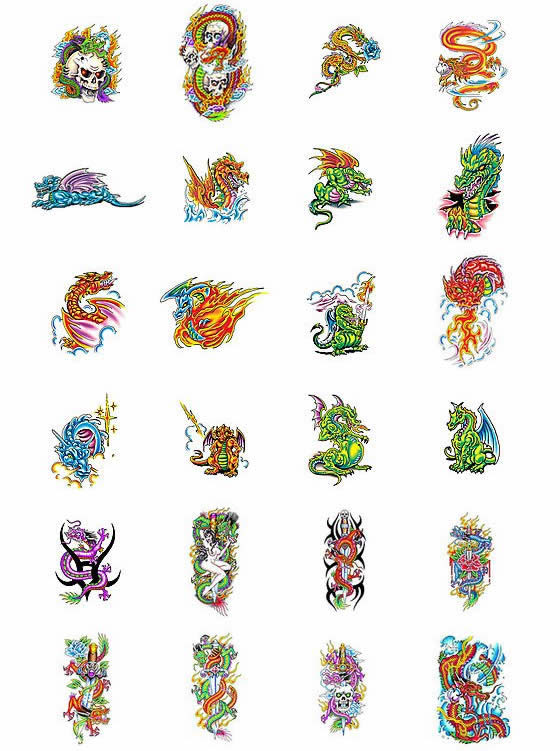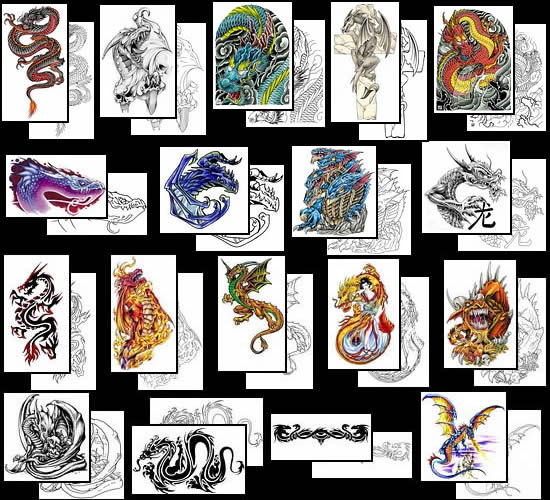|
|
|||
 |
|||
|
TATTOO DESIGNS & SYMBOLS - DRAGON
Tattoo Symbol Index - A B C D E F G H I J K L M N O P Q R S T U V W X Y Z Tattoo designs - D >> Dragons Dragon Tattoo Meanings -The dragon is a "classic" tattoo motif, popular with both men and women. As a tattoo design the dragon shows the profound influence that Japanese and Chinese culture have had in Western tattooing for nearly two centuries. In the Far East, the dragon represents the Four Elements - Earth, Wind, Fire and Water - and the four points of the compass - East, West, North and South - and dragons are simultaneously a symbol of Water, Earth, Underworld and Sky. The dragon is a culturally far-ranging character whose apparent bad temper should be interpreted as simply amoral, neither good nor evil. The forces of nature are not human-hearted, representing as they do the cycle of life and death, followed again by birth and renewal. Nature nurtures and nature destroys. So too, does the dragon.
The dragon came to represent both the beneficent and malevolent elements, depending on which part of the world it breathed its fiery breath. In China, these mythological creatures were the symbol of both the supernatural and of imperial power, residing in the heavenly realms. They were often spotted looming around thunder clouds, and became the deities of rain, producing downpours when it suited them. As shape-shifting creatures, they became so embedded in the myths and legends of Chinese culture, that the dragon is said to be the ancestor of the Chinese people. In Japan, a similar claim was made when a certain emperor declared that he was a direct descendant, himself, of the powerful and immortal dragon. It's not surprising then, that the image of the dragon appeared on the robes of the emperor, signifying the protective powers of the dragon as well as the temporal power of the emperor. As Dragons were said to represent the Four Elements, so the stories and myths of dragons who had dominion over Air, Water, Earth and Fire. Each of these elemental dragons had unique characteristics that had to be taken into consideration. To the Chinese, the fire-spitting dragon was principally associated with lightning, and by extension to thunder and rainmaking, which made it a symbol of fertility. All this celestial activity was how Earth and Water elements were united. Water dragons were thought to protect and act as guardians of streams, lakes, rivers and even individual pools. It was thought that dragons were able to make springs bubble from the ground. In addition to the elemental dragons there were also unique dragons of myth, legend and lore. There were dragons who guarded special treasures or dragons who were charged with special tasks, quests and responsibilities. Dragons often controlled or had in their possession Pearls of Wisdom and other jewels or items with magical properties that conveyed great power to those who possessed it. The rain bearing power of thunder was often depicted as a pearl held in the dragon's mouth or throat. Over time, the dragon's pearl also stood for the king's purity of thought or the perfection of his commands. "You do not argue with the dragon's pearl", said Chairman Mao. Both Japanese and Chinese lore are also filled with stories of creatures, who, through their special quests, at the end of their journeys, were transformed into dragons. In Japan, these were often the stories of Carp and Koi who through their perseverance, journeys and struggles, in the end were transformed into dragons. Before the advent of Buddhism, the dragon starred in Chinese and Japanese folk beliefs, and in Taoism. In the ninth century, the Chinese incorporated the dragon into Buddhist concepts and art, where it took on the role of protecting Buddha and the sacred law of Buddhism. It could be found over temple doors and on tomb walls, warding off evil spirits. The most recognizable dragon image is the one that appeared in ninth century Tang ink drawings. They sported the long, scaly body, the claw feet, small horns, large eyes under bushy eyebrows, and sharp teeth. In a gentler, wingless aspect, it was associated with the rainbow. In the West, the dragon's serpentine looks connoted evil. Blame its serpent relative making trouble for itself and all mankind in the Garden of Eden. Later, some famous Christian saints did battle with the fire-breathing dragon, Michael and Saint George, to name two. In images depicting the famous battle with Saint George, the dragon is portrayed as a sea dragon, and the patron saint of England is the clear winner. In battles all over the Roman and Greek empires, warriors boasted the emblem of the dragon as a symbol of terror. It was seen on Viking ships, and in Celtic cultures it was the emblem of sovereign power. Anglo-Saxons had it emblazoned on their standards. Today, the red dragon is the national emblem of Wales, and believed to be a relic of Roman times in ancient Britain. Wherever the dragon appeared, its strength and power was supreme, whether it was used as protection, or a force to be overcome. Defeating the fire-breathing dragon was the supreme test of human courage and fortitude. Legends abound of heroes of ancient Greece battling with the guardians of lakes, gates and marshland. The dragon that the Greek hero, Jason, slew in his pursuit of the stolen Golden Fleece is the same monster appearing in stone on the castle tower in the city of Ljubljana, Slovenia. Today we see the dragon in all it's fantastic, heavenly and monstrous aspects. In Chinese astrology, it is said that if you are born under the sign of the dragon, you will be a leader, albeit a bossy one, and in Feng Shui, when you place coins of the "Yang" Dragon tied together with coins of the "Yin" Phoenix chances of marital bliss will reach heavenly heights. The word "dragon" is derived from the French and Latin form of the Greek "draku", linked with "derkomai", meaning "to see" and interpreted as "sharp-sighted". The equivalent English word "drake" or fire-drake- is derived from Anglo-Saxon "draca". (Encyclopedia Britannica, 1959.)
Get inspired by some really amazing images and photos of dragons in our Dragon Inspiration Gallery See also Fire Dragons, Water Dragons, Japanese Tattoo Index |
||
 |
|||
Choose your own dragon tattoo design from Tattoo-Art.com.
Choose your own dragon tattoo design from the world's top tattoo artists at TattooJohnny.com and buy the perfect dragon design for you. Get Dragon designs on t-shirts, hats, sweatshirts, bags & more. Tattoo designs - D >> Dragons Tattoo Symbol Index - A B C D E F G H I J K L M N O P Q R S T U V W X Y Z |
|||
| Celeb Tattoos | Facts & Stats | Designs & Symbols | History | Culture | Links | Tattoo Galleries | Contact | |||
|
|
|||








